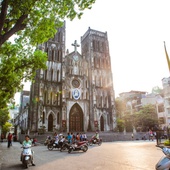Travel Tips: Taking Local Bus Like A Local
Traveling by bus continues to be an increasingly popular option in Hanoi, especially due to its affordability and ease of use. If you’re on a budget and want to immerse yourself in the local culture, taking the bus is definitely a choice worth considering.
How to recognize the bus and bus stop on the street?
Buses in Hanoi are easily identifiable by their vibrant color scheme, typically featuring white, red, and yellow. Each bus is marked with a number in red, displayed prominently within a white circle at the front of the bus.
 Hanoi Bus
Hanoi Bus
Bus stops are marked with blue signs displaying detailed routes of each bus line. At major bus stops, you will also find maps of the city and information on other routes. Buses operate every 5 to 15 minutes, from 5:00 a.m. to 9:00 p.m.
Ticket price
You won’t have to worry about spending too much when traveling by bus in the city since ticket prices have remained low for quite some time.
The price of a bus ticket varies depending on the distance traveled:
Inside Hanoi: VND 10,000
Buses number 07 and 17 to the airport: VND 20,000
Buses to nearby provinces: VND 30,000 - VND 70,000
Each bus clearly displays its ticket prices along the windows in red letters. The price is uniform for everyone, including locals and tourists, so you can rest assured that there will be no issues with overcharging.
Each ticket is valid for a single journey on one route. It’s essential to keep your ticket while on the bus for random inspections. Tickets are available for purchase directly from the bus conductor, and cash payments are required. To expedite the process, it’s advisable to carry small denominations.
Need-to-know bus routes
Buses remain the primary means of public transport in Hanoi, covering nearly every major street in the city. While the urban metro network has become operational, the bus system continues to provide essential access to popular tourist destinations such as Hoan Kiem Lake, the Old Quarter, Hanoi Train Station (Ga Hanoi), Ho Chi Minh Mausoleum, the Temple of Literature, and various museums. Here are some key bus routes to remember:
Bus number 7 and number 17: These buses connect to Noi Bai Airport, North Vietnam's key gateway. Bus number 7 travels via Thang Long Bridge to Cau Giay, while bus number 17 heads to the Old Quarter through Chuong Duong Bridge.
Bus number 9 and number 14: Both routes stop at Hoan Kiem Lake, inviting you to explore the surrounding area and the Old Quarter. Bus number 9 also stops at Le Hong Phong and Dien Bien Phu Streets, near the Ho Chi Minh Mausoleum, while bus number 14 will take you to West Lake, home to attractions like Tran Quoc Pagoda and Quan Thanh Pagoda.
Bus number 33 and number 2: These routes lead you near Ho Chi Minh Mausoleum, allowing you to wander along the city's beautiful boulevards such as Dien Bien Phu, Le Hong Phong, and the lush Phan Dinh Phung, before reaching the Ho Chi Minh complex.
Bus number 47: This line departs from Long Bien terminal and will take you to Bat Trang pottery village!
To navigate effectively, consider purchasing a bus route map at the bus terminal, which includes detailed information on bus numbers, stops, and complete routes. This map will help you create your itinerary for exploring the area.
Be a “local” passenger
Now that you know how to catch the right bus and buy a ticket, you're almost ready to join the ranks of Hanoi's local passengers! However, there are a few more things to keep in mind. You may encounter some challenges while using the bus system in Hanoi.
Buses can become very crowded, particularly during peak hours (roughly from 6:30 to 8:00 a.m. and 4:00 to 7:00 p.m.), primarily filled with students. Heavy traffic during rush hours can also lead to delays, which can be frustrating. It's advisable to avoid traveling by bus during these times, especially if you’re in a hurry.
As your bus approaches your destination, try to navigate to the back door; if the bus is overcrowded, you can request to use the front exit. Be prepared for a quick disembark, as bus drivers are known for their brief stops. If you don’t move quickly, you might find yourself taking a half-kilometer walk back from the next stop.
While some buses that service the Old Quarter announce stops, these announcements are typically in Vietnamese, which may make it challenging for non-speakers. If you're unclear about your stop, don’t hesitate to ask the bus driver, ticket collector, or fellow passengers (younger commuters may be more fluent in English). Carrying a piece of paper with your destination written down can also facilitate communication in case locals have difficulty understanding you.
Though it may seem daunting, traveling by bus in Hanoi is an authentic local experience worth embracing.

Best Time To Visit Hanoi
Generally, climate in Hanoi is typical of tropical monsoon climate in the North of Vietnam with the hot - wet summer and cold – dry winter.

7 Best Places To Go In Hanoi Over Tet Holiday
If you’ve ever stayed in Hanoi over Tet holiday—Lunar New Year—you know this: it’s desolate.

Hanoi Travel Directory
If you do not know how to navigate through the mountain of information published on Vietnam Online and elsewhere in the world about Hanoi, this is your one stop guide to travel and living in Hanoi.








